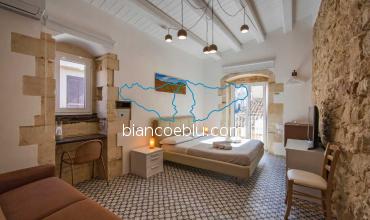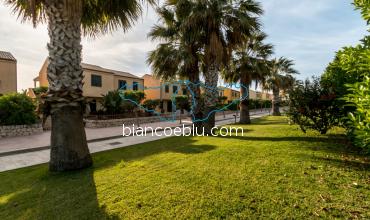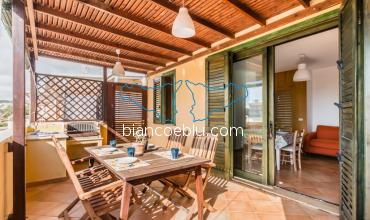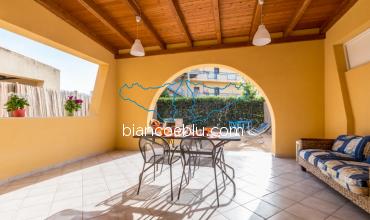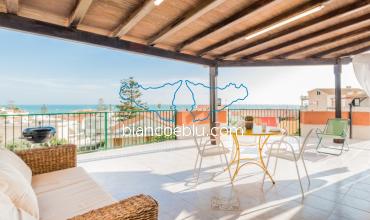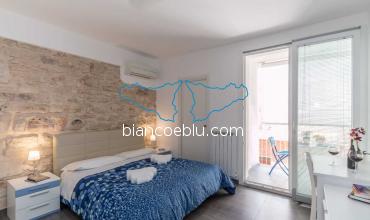The town of Modica is a jewel carved in the Iblean rocks, situated in South-Eastern Sicily, and a UNESCO heritage site since 2002. Built on several levels, it is divided into neighborhoods that have different spirits but form part of a single necklace, named the Baroque of the "Val di Noto". The town grew up on the rocky hills that surround it and goes towards a rocky valley, once a river bed, in the past 17 bridges were built to connect the various parts of Modica.
The structure of Modica’s historical center is a perfect example of the medieval style, yet it is the late Baroque style that dominates the architecture of the historic buildings and churches, most of which were rebuilt after the earthquake that struck Eastern Sicily in 1693.
The town has an important historical and aristocratic past, it is situated 15 km away from Ragusa and 20 km away from the Marina di Modica coastline, the origin of its name is not certain, it is thought to refer to the Phoenician term Mùtika which means "hotel".
- Information
- Map of Modica
- Where to stay
- How to get to Modica
- Beaches
- What to see
- Things to do
- Where to eat
Information about Modica
Historical events
The place known today as Modica existed since the prehistoric age as suggested by the rocky ruins that surround the city, between the fifteenth and nineteenth centuries the city was a County and was one of the most important feudal estates of Sicily and the south of Italy due to its political, cultural and economic weight; the county of Modica included the entire territory of the current province of Ragusa.
Witnesses of this glorious past are the ruins of a castle located on one of the rocks that stands out and dominates the historic center of Modica Bassa, with its clock constructed in 1725 and still functioning.
The colors of the limestone typical of the Province of Ragusa are dominating in Modica. Massed houses, narrow alleys, and sumptuous churches will give you a full idea of the Baroque architecture of the eighteenth century. Modica is a beautiful city in the province of Ragusa with various churches and UNESCO heritage buildings.
.
Modica today
Modica is a dynamic city, which grows from an economic point of view is based on its remarkable business climate, where traditions are accompanied by innovations and, although part of the province of Ragusa, it is a self-sufficient city with all the services and structures present on its territory.
It has four well-known districts: Modica Alta, the oldest one, Modica Bassa founded in the early twentieth century, when the bed of the Modica river was elaborated, creating the main street of the city, Modica Dente in the upper eastern part and Modica Sorda, the most residential district born in the sixties of the last century, today it is also the center of the commercial center of the city.
In Modica, the colours of limestone typical of the Province of Ragusa dominate, massed houses, narrow alleyways and sumptuous churches characterize the eighteenth-century Baroque architecture.
MODICA’s MAP
The city’s life goes through its alleys and its stairways that connect the various corners of the city where the transformation of the territory is more evident, aiming to adapt the environment to man's needs to make it comfortable, as demonstrated by its crowded houses and caves in the rocks.
On state road 115 you can find the Costanzo bridge, 168 meters, one of the highest in Europe, that connects Ragusa and Modica and allows access to the various parts of the city via the ring road, its territory includes both the mountain districts Frigintini and Zappulla, and maritime ones: Marina di Modica and Maganuco with their splendid beaches.
Modica's accomodation
Even though there are many places to stay in Modica, including hotels, b&bs, and holiday hoouses, we advise you to stay in Marina di Ragusa, a strategic place to move easily to all the neighboring areas and at the same time enjoy the excellent climate and the fantastic blue flag beaches.
In Marina di Ragusa we will be happy to welcome you, with our best offers, all with the necessary services included to spend a nice holiday, enjoying the excellent climate, good food, and complete leisure!
Cozy rooms in B&Bs, apartments, and single houses, all equipped with services and designed for your comfort. Our structures are located near the center of Marina di Ragusa and are very close to the sea which, with its very fine and clean beach, is the pride of the Province of Ragusa. Everything is hand close including supermarkets, restaurants, nightclubs, fast-food outlets, bars, and shops of various types.
HOW TO GET TO MODICA
by plane transport
The best way to reach Sicily is by plane, then to get around it is advisable to have a car or use the buses.
There are four airports in Sicily: Catania Airport and Comiso Airport operate in the eastern part, Palermo Airport and Trapani Airport in the western part of the island.
- Catania Airport: the busiest airport in Sicily with thousands of daily arrivals and departures for national and international flights.
- Comiso Airport: the latest one, built in the old NATO base in Comiso, is still not so busy, however, there are daily flights operated by Rayanair, Alitalia, AirMalta, Brussels Airlines.
- Palermo Airport: it is the second most important Sicilian airport, with national and international connections, it is located 35 km from Palermo.
- Trapani airport: is more used as a military airport, yet in the same time it is a civil airport where both Ryanair and Alitalia operate.
By ground transport
To get to Modica we recommend the use of the bus or car, as the trains in this part of Sicily are not very fast.
Bus
The bus company that connects Modica with the other Sicilian cities is AST, we advise you to look at their website to check the timetables of the routes you need. From Modica it is also possible to reach Scicli, Donnalucata, Noto, Avola, Rosolini, Ispica, Pozzallo, Syracuse, Gela, Acate, Pedalino, Chiaramonte. The information site is www.aziendasiciliacanasporti.it
- Catania - Modica bus: the two cities are about 125 km apart and are connected by numerous daily routes which also stop at Catania airport on both ways of route, the complete route from Catania central station to Modica piazzale Falcone-Borsellino is about 2 hours.
- Syracuse - Modica bus: the two cities are very close the distance between them is about 74 km which can be traveled by bus in less than two hours.
- Palermo - Modica bus: this route is the longest one, as it crosses the Sicilian inland, and it takes around 4 and a half hours for approximately 275 km, always with the AST bus company.
- Trapani - Modica bus: from Trapani, there are no direct buses to Modica, you have to get to Palermo and take the AST bus.
- Ragusa - Modica bus: the short journey of about 30 minutes is operated by Ast bus. A distance of 15 km, is covered with several routes a day.
- Marina di Ragusa - Modica bus: once you arrive at Piazzale Zama in Ragusa with the Tumino Trasporti bus, take the Ast bus to get to Modica. For timetables visit the page www.tuminobus.it
Car
The most comfortable way to get to Modica and visit all the neighboring areas of eastern Sicily is by car.
- By car from Catania Airport to Modica: it is around 121 km journey, at the airport exit reach the highway towards Syracuse and continue on the E45 Catania–Siracusa exiting at Rosolini, continue on the state road 115 towards Ispica and following indications arrive Modica, estimated time is around 1 hour and a half.
- By car from Comiso Airport to Modica: the distance to cover is about 43 km, on leaving the airport, take the SS514 state road and then the SS115 which will take you to Modica in about 40 minutes.
- By car from Palermo Airport to Modica: there are about 298 km away from the Falcone-Borsellino airport in Modica, from the airport exit take the A29 towards Palermo then take the A19 towards Catania continuing on the A19/E932 and then take on the E45/SS114, all in about 3 hours and 45 minutes.
- By car from Trapani Airport to Modica: with a distance of 428 km and 4 hours and 30 minutes from this airport, in terms of time, this route is the worst to take to get to Modica.
Modica’s beaches
Marina di Modica beaches
The seaside village Marina di Modica, which makes part of Modica’s fraction, is about 20 km away from the town. There are two beaches: one has the main access in the center of the town from Piazzale Mediterraneo, still, it can be accessed from many other visible points, the other is Maganuco beach.
Marina di Modica is a very quiet country place even during the summer when it becomes inhabited by the residents of Modica, who move into their summer houses and spend the summer there, dedicating it to tranquility and rest. It is a very popular destination for surfing and especially for all windsurfing fans, due to the position that favors currents and thus creating the possibility of finding better waves to practice these water sports in the crystal clear waters of its coast.
Shops, bars, restaurants, and lidos offer all the necessary services to spend a nice holiday, the spacious and well-kept promenade starts from the piazza Mediterraneo and goes to the west to the wild and rocky bathing cliff with a particular charm.
You can find large free parking spaces where you can leave your car, they are situated in various parts of the village, not far from the beach, it is possible as well to park a car in the streets, where signs allow.
The Maganuco beach, in the commune of Modica, is remarkable with its wide beach that goes for 500 meters towards Pozzallo direction, the distinctive feature of this beach is the crystal clear waters, the wind that favors water sports, the dunes with the Mediterranean marine scrub and the marshes with green areas, where birdwatchers can watch over various rare specimens such as the sultan chicken or the diving duck. The beach has lidos with all the necessary facilities, has a large car park and, although wild, is welcoming, therefore, an ideal place to spend a day in absolute leisure.
Lidos in Marina di Modica
There are many nice lidos on the free beaches of Marina di Modica and Maganuco, remarkable for the savage charm of their cliffs, marshes, and beaches of fine sand that embed the crystal-clear sea. All the lidos are equipped with the stuff to rent – deck chairs, umbrellas, boats, and water sports equipment. There you can spend all day long thanks to the restaurants inside of them and livened up with various events organized all summer season long.
- Lido Sud - via arenile 1-334 361 9672
- Scirocco lido - piazza mediterraneo 48
- Corallo food & beach - via arenile -338 777 6122
- Uva beach club - via Cristoforo colombo 347 282 4109
- Shuluq - lungomare Marina di Modica – 328 846 4198
- Oasi Maganuco Beach club - piazza Santa Chiara -0932 185 2362
- Carizza Maganuco beach club - contrada Maganuco- 333 603 8177
Beaches near Marina di Modica
Once arrived at the calm seaside resort of Marina di Modica, you can travel by car to get to the nearby beaches, all of which have beaches with all the necessary facilities, with bars and restaurants, pizzerias, and pubs.
Beaches to the West side of Marina di Modica:
- In About 5 minutes’ drive on the provincial road, you will reach Sampieri with its beautiful beach, with a pine forest on the seafront that goes to the small port. Sampieri has also been used as the natural scenery for filming "Il Commissario Montalbano" in recent years. The symbol of the seaside village is the Fornace Penna which stands out between the sky and the sea.
- Following the provincial road to the west, you will come across the beach of Costa di Carro, a beautiful natural gulf, with a large car park where you can leave your car.
- 14 minutes away from Marina di Modica you will find Cava d'Aliga with its beaches, sea caves, and rocky coastlines.
- A few minutes away from Cava d'Aliga there is Donnalucata, the beautiful populous town that welcomes you with its beautiful golden sandy beaches and crystal clear sea.
- Keep going west you will reach Marina di Ragusa, the queen of Ragusa’s nightlife. Its wonderful promenade, the beaches with very fine sand, the clubs, and the events of the season make this village a popular destination to stay and spend the night.
- A few kilometers away from Marina di Ragusa you can visit Punta Secca, where the scenery is familiar with the lighthouse that stands out in the sky. Because it is the place where the house of Inspector Montalbano is located and there is also one of the restaurants which became famous thanks to the TV series: "Enzo a Mare".
To the east of Marina di Modica are:
- Pozzallo is 12 minutes away and it is a stop not to be missed with large sandy beaches framing a crystal clear sea, With The tower Cabrera as a symbol of the city and the cheerful and inviting atmosphere of the whole town.
- In just 22 minutes you will reach Santa Maria del Focallo. The beach of the municipality of Ispica, is uncontaminated, sometimes savage, yet beautiful.
- 6 minutes from S. Maria del Focallo is situated Punta Cirica, an incredible beach with an exotic air, the caves on the sea here are the patrons.
- Just 7 minutes by car from Punta Cirica you will arrive at Baja Porto Ulisse, which must be visited for the beauty of its rocks.
- Passing Punta Cirica, in just 25 minutes away, you will arrive at Punta delle Formiche, in the commune of Pachino, in the province of Syracuse. A beach with all necessary facilities and untouched nature with cliffs, caves, and a crystal clear sea. From the beach, you can see the island of currents.
WHAT TO SEE IN MODICA
Modica has been recognized as a "World Heritage Site" by UNESCO, thanks to the various architectural jewels existing there. In Modica, you relive history full of the important events of its past surrounded by the art that oozes from every building, from every corner with its infinite stairways and the majestic beauty of the city view, which appears like a crib immersed in the colors of the Sicilian Baroque.
All the districts of the city have something to tell and show, the picturesque Jewish quarter of "Cartellone" which from its top, gives the possibility to see the panorama of the Cathedral of San Pietro.
The Pizzo district with its belvedere is the place to take the most beautiful photographs of the San Giorgio cathedral.
If you will go to the Monserrato district, via Vanella 139 by car - near the pylons to be more precise - and from there let yourself be enchanted by the view of the city that unfolds before your eyes.
In the historic center of Modica among churches, palaces, narrow streets, museums, and picturesque neighborhoods there are shops, souvenirs, pastry shops that sell the famous Modica chocolate and bars, cafes, restaurants, and pizzerias that will add colors to the day of those who want to spend here even just one day.
Historical palaces and Churches in Modica
Modica should be discovered by walking through its streets and infinite steps always going up and down. You will discover that, although the centuries have passed, time seems to have stopped and the County, political and historical power center for the ancient south, is still impressively vivid.
Castello dei Conti di Modica: It is a symbol of the historical power of the Modica County that soars over the town and was built around the 14th century on a rock shaped like an eagle’s beak. It is definitely worthy of the visit .
Palazzo Castro-Polara-Grimaldi: It is possible to admire the beauty of this palace, built between the 19th and 20th centuries by the Cavaliere Castro in honor of his wife, a descendent of the Monaco royal family just several meters away from the Duomo di San Giorgio.
Other buildings of historical value:
- Palazzo della Cultura
- Palazzo Grimaldi
- Teatro Garibaldi
- Torretta dell’Orologio
- Il duomo di San Pietro
Majestic Duomo di San Pietro: the monument is a part of UNESCO World Heritage and was built in the 14th century. It is located at the very heart of the Modica Bassa and marked with stairs adorned with the statues of 12 apostles that lead to the churchyard with its decorated façade.
Il Duomo di San Giorgio: 62 meters high soars over the Modica Alta and its artistic steps and its hanging gardens frame it like a real pearl of late Baroque. The Duomo is part of UNESCO World Heritage.
La Chiesa del Carmine: this church is situated at the Modica Bassa and survived the earthquake, that demolished Val di Noto in 1693. Its portal in Chiaramonte Gothic style dates back to the end of the 14th century and inside it, there are valuable artistic works.
.
Other churches of historical value
Other churches of historical value
- La chiesa di San Giovanni Evangelista
- Convento del Carmine
- La chiesa di Santa Maria del Gesù
- Chiesa di Santa Maria di Betlem
Archeological remains in Modica
Canyon e Cave
Cava Ispica: Once entering Modica from the countryside you can reach a site of great naturalistic value: Cava Ispica is 13 km long and includes the territories of Modica, Ispica, and Rosolini, where beyond the Mediterranean scrab there are caves, rock churches, and the settlements of the troglodyte with a prehistoric necropolis and Christian catacombs.
Cava Lazzaro: Cava Lazzaro is situated between the communes of Modica and Rosolini and exists since the Bronze Age. It is an important historical and archaeological testimony, remains of the early Christian and Byzantine eras have also been found
Cava dei Servi: it is an area of remarkable beauty alternating overhanging rock walls with deep gorges crossed by the water of the Tellesimo stream, with oak woods and stretches of Mediterranean scrub invaded by wild thyme bushes. Its fauna is also rich and varied. Here too there are remains of necropolises dated back to the Bronze Age.
Museums in Modica
Museo del Cioccolato: Modica chocolate is recognized as a PGI product by the European Union and is a symbol of Modica. In the rooms of the Chocolate Museum, you can make a gastronomic journey by finding out the methods of making this product, through the exhibition of tools and photos, as well as the history of chocolate from the pre-Columbian age to today - Corso Umberto I, 149 - Modica Bassa tel. 3474612771.
Casa Museo di Salvatore Quasimodo: it is the birthplace of the Nobel Prize winner for literature Salvatore Quasimodo. There he lived for a few months after his birth; the furnishings are original from the early twentieth century, and many of the objects come from the Maestro's studio in Milan - via Posterla 84 –Modica Bassa 3315876218.
Casa Museo di Tommaso Campailla: a few steps away from Quasimodo's house under the castle of the Counts, you can also visit the House Museum of Tommaso Campailla, a well-known philosopher in the circle of eighteenth-century thinkers, he was the creator of the mercurial stoves used for the treatment of syphilis.- via Posterla 29 –Modica Bassa
Museo Civico “Franco Libero Belgiorno”: in the Civic Museum of Modica, situated in the historic rooms of the Palazzo della Cultura; it is possible to see the paleontological relicts from the Neolithic and Bronze Ages, many of which were found in the caves around the city, one room of the museum is left for the exhibition of the most important piece: the bronze of the Heracles of Cafeo of the III century. B.C. In other rooms there is a permanent exhibition of a collection of paintings that belonged to Salvatore Quasimodo; The lower floor of the Civic Museum houses the Workers' Mutual Aid Society which promotes various displays, exhibitions, and cultural meetings during the year - Corso Umberto I, 149 Modica Bassa.
Montalbano places in Modica: Modica was used as the stage in the fiction "Il Commissario Montalbano", its palaces such as Palazzo Polara, an architectural jewel of the late Baroque and the hanging gardens of the Cathedral of San Giorgio, the stairways both of the Cathedral of San Giorgio and of the Cathedral of San Pietro, the panorama of the houses with the colors of gold colored by the sun have been the protagonists for several times. Discover "The Places of Montalbano".
What to see near Modica
What to see in less than an hour from Modica
- Ragusa is around 25 km away, it is one more gem of Sicilian Baroque to visit, and it makes part of UNESCO World Heritage.
- The lovely town Scicli is 16 km away and it is also part of UNESCO World Heritage from it in less than 10 minutes one can get to sea villages such as Donnalucata, Cava D’Aliga a Sampieri.
- Marina di Ragusa is 20 km away, it deserves its name of Ragusa’s nightlife queen and is a central gem of the set of Ragusa’s beaches thanks to its beaches and roads.
- Coastal town Pozzallo with its beautiful gothic Cabrera Tower that soars over the promenade is 18 away.
- The welcoming town of Ispica is 17 km away. It is nestled on the hills and with its roads of white stones looks almost shining under the sunlight.
- Enchanting Castello di Donnafugata is one more place to visit, it is 35 km away from Modica, and was the old residence of aristocrats known as “Leopards”, nowadays it functions as a museum.
- Noto is 37 km away from Modica. It is the cradle of the Eastern Sicilian Baroque.
- Marzamemi is 41 km away. Its picturesque historical center is full of bars and restaurants where one could taste excellent local seafood.
What to see in less than two hours by car from Modica.
- Catania is 120 km away from Modica. It is the vibrant center of Eastern Sicily both from the economical and artistical points of view.
- Siracusa, one more Sicilian city, is 72 km away. It is a symbol of Ancient Greece’s domination with its Aretusa origin and charming historical center called Ortigia.
- The town of Enna is 138 km away, it is nestled at almost 1000 m over the sea level, and has a unique structure of the castle, called by Romans “invincible”.
- Caltagirone is 76 km away. Here the Arabian ceramic craft marked all the architecture of the town and made it known by the wonderful souvenir of ceramic.
- Piazza Armerina is 107 km away. It is a town with medieval structure, with the gems of Baroque style, Norman, and even Roman style, represented by famous mosaics on its villas.
THINGS TO DO IN MODICA
If you ask yourself what to do in Modica you will be confused with a choice among the various saint patron festivals, touching and very interesting that attract thousands of people making the city celebrations even more joyful, as well as for the festivals and nightlife of the city with its flavors and entertainment that are always characterized by good live music and with the possibility of making good meetings in the neighborhoods where the nightlife takes place between a cocktail and an appetizer.
Patronal feasts and festivals in Modica
The patronal feasts in Modica are very touching, the believers and nonbelievers on this occasion unite in living unforgettable moments, experiencing times when traditions, customs, and devotions are revived annually through a liturgy that brings visitors from all over the world.
The feast of San Giorgio: takes place in the week after April 23, and has very ancient origins dating back to 1090 AC. The Statue of the saint is carried on horseback and leads the procession and the bearers stage the horse's race by running and stopping several times along the way, all immersed in a festive atmosphere, created by the inevitable stalls, band music, and fireworks.
The feast of San Pietro: takes place on June 29 with the sacred relics of the Saint carried in procession together with the statue of San Pietro carried on the shoulders of many bearers. On this occasion, the streets of the historic center are illuminated for three days and the stalls of the "Fiera di San Pietro" invade the historic center, where no one misses the opportunity to discover, taste and admire the traditions, flavors, and art.
The feast of the Madonna "Vasa Vasa": takes place at Easter and is in form of a ritual that occupies the whole historic center, when at the stroke of noon following the musical band the Madonna is carried in procession, and "dressed in mourning" meets the risen Jesus and she kisses him while white doves are liberated into the sky and she takes off her black dress, the dialectal term "vasa vasa" indicates the kiss between the two, this particular moment created on the model of the Sicilian puppets is the most awaited by the crowd.
.
ChocoModica: it is the Modica chocolate festival, traditionally taking place in April. Between the discovery of the unique and unmistakable flavor of Modica chocolate, which has now become a symbol of the city and known all over the world, visitors can immerse themselves in an engaging party between tastings, conferences, demonstrations, and entertainment: the whole historic center in those days is "sweetly" super welcoming.
ChocoModica: it is the Modica chocolate festival, traditionally taking place in April. Between the discovery of the unique and unmistakable flavor of Modica chocolate, which has now become a symbol of the city and known all over the world, visitors can immerse themselves in an engaging party between tastings, conferences, demonstrations, and entertainment: the whole historic center in those days is "sweetly" super welcoming.
The Ricotta Festival: it takes place in the period between May and June, you can take part in this annual event where you can taste the ricotta and all the products made from it, the result of the tradition and skill of local pastry chefs and cooks.
The Carubba Festival: an interesting festival of a product that is not very well known but is widely used both in pastry and in the kitchen. This festival takes place in the village of Frigintini, in autumn, where you can taste many products made of carob tree fruits, both sweet and salty. The local restaurants prepare also dishes with carob tree mushrooms, a very rare delicacy that can grow up even more than 10 kilos.
Nightlife at Modica
The Modica’s nights always have a musical background thanks to the various live music events. The streets of the historical center become alive thanks to the numerous places where it is possible to eat, drink, and meet new people. Piazza Matteotti where there are many pubs and night facilities is the meeting point for young people. Via Grimaldi, the steps of the cathedral of San Pietro and the narrow streets become open-air conversation lounges where one can pleasantly spend the evening until late at night among jazz, pop, and ethnic music festivals. Even in the marine villages in the summer organize various entertainment events fill and color the evenings with music, drive-ins, dances, and cabaret.
Local markets at Modica
Agricultural markets
Commercial markets
- Monday at Piazza Donatello - Marina di Modica
- Thursday at piazzale dello stadio “Pietro Scollo” c. da Caitina Modica
Excursions at Modica
It is possible to visit the places of particular faunal, naturalistic, and archaeological interest, such as various canyons that offer the Modica area. We do not advise you to do it alone. You can get information and participate in trekking itineraries organized by expert guides and the possibility of tastings along the way with the Kalura association: www.kalura.org
Of remarkable interest are:
The alternative to excursions on foot is the excursion by bus, which is possible with the agency "La terra Viaggi". It organizes excursions in the province of Ragusa and all over Sicily. To organize a nice day trip or multi-day tour comfortably seated on a bus, we recommend you to check the website www.laterra.it and to book what you prefer to see or go to its offices in Ragusa, Marina di Ragusa or Modica.
WHERE TO EAT AT MODICA
The art of cooking and eating well is deeply rooted in the local traditions, where simple ingredients create delightful dishes. Here Sicilian traditions were influenced by those, which arrived from over sea lands making possible the creation of a Mediterranean miracle, with food, flavor, and fragrances combined exactly the way that has made famous Sicilian cuisine all over the world. Everything is tasty, from street food to the most sophisticated dishes, because includes traditional ingredients.
Typical products:
The millennium history of Sicilian cuisine with the ingredients that come from everywhere was born at the crossroad of the cultures that dominated the island over the past centuries. Modica is the guardian of taste and elegance.
The most famous product is the Chocolate of Modica, created at the times of Contea di Modica governed by the Spanish. The peculiarity of this chocolate is in its elaboration in low temperatures when the sugar doesn’t melt and leaves the small crystals inside of the bare, making it crispy. It is highlighted with the flavors of carob cinnamon, , jasmine, chili…..
One more particular and good pastry product is the Impanatigghie biscuit shaped like a crescent - moon filled with chocolate, cinnamon, and ground beef. The ancient recipe used by pilgrims who, exhausted by days of travel, brought this sweet with them to restore their strength.
Among the savory dishes to mention the homemade pasta such as ricotta ravioli and cavatelli with pork sauce.
The Modica pies are made with meat or vegetables and cheese.
Also, Modica’s cheeses are perfect to taste and to bring with you from the visit to Modica.
Restaurants and pizzerias
It is real confusion to choose the right place in Modica when it is time to eat, It is almost mandatory to stop in the local restaurants, that serve the typical local food, yet pizzerias, street food bars, and pastry shops will not delude you as they offer the dishes of high quality.
Here we will suggest you some of them:
- A putia ro vino: is a distinctive place, worthy of the uphill road towards it all by foot, circling among the narrow streets of the historical center. Here you can find forgotten natural flavors, typical and traditional for Modica’s countryside, that will enrich your experience of the gastronomic traveler– via Pisacane 34- 0932 94 41 57
- Accursio restaurant: will take you on a gastronomical trip of pleasure through the harmony of the Sicilian flavors that are created here by the refined cuisine of the chef, who works over the new tastes and sensations. - via Clemente Grimaldi 41 – 0932941689
- Pizzeria Ristorante La Contea: The right place to taste a high-quality pizza with a good quality/price ratio -via Grimaldi 15/17 Modica Bassa 0932944812
- Pizzeria Ristorante Smile: even this place offers dishes of high quality with takeaway possibilities. Perfect quality/price ratio even here- via Guglielmo Marconi 17, Modica Alta 0932946666
Fast food
- Rosticceria Antichi Sapori: real kingdom of sicilian traditional food (arancini, pastieri, tomasine, pastizzi, impanate e soprattutto scacce of modica)-corso Vittorio Emanuele 2- 0932942728
- Putia del Coppo Street food: it is an explosion of fried fish and snacks and many other dishes. In this place selfservice is possible -corso Umberto I 197-3394895672
Agritourism
- Agriturismo Al Monte: is a perfect place to taste traditional dishes and flavors: cavatelli ,sugo di maiale, ricotta calda, scacce modicane it is possible also to visit the local animal farm-contrada Monte Margi 31-Modica-0932948469
- Agriturismo Sant’Antonio: it is immersed in the country scenery of the Modica province. This agritourism can host numerous guests and offers the best traditional flavors that depend on the season: fresh meat and homemade bread - contrada Trecasucce Torre Rodosta 151-0932903570
Ice cream and pastry shops
- Antica dolceria Bonajuto: it is impossible to visit Modica without tasting cannoli, local chocolate or orange pastry together with all the other delights offered by this pasty shop -corso Umberto I 159-0932941225
- Laboratorio Don Puglisi: is a pastry shop that manufactures its own chocolate and other typical sweets of the Modica’s pastry -largo XI febbraio 158-0932751786
- Caffè dell’arte: is a bar where in addition to the most known pastriesone could taste delicious sicilian granite with brioches -corso Umberto I, 114-0932943257









